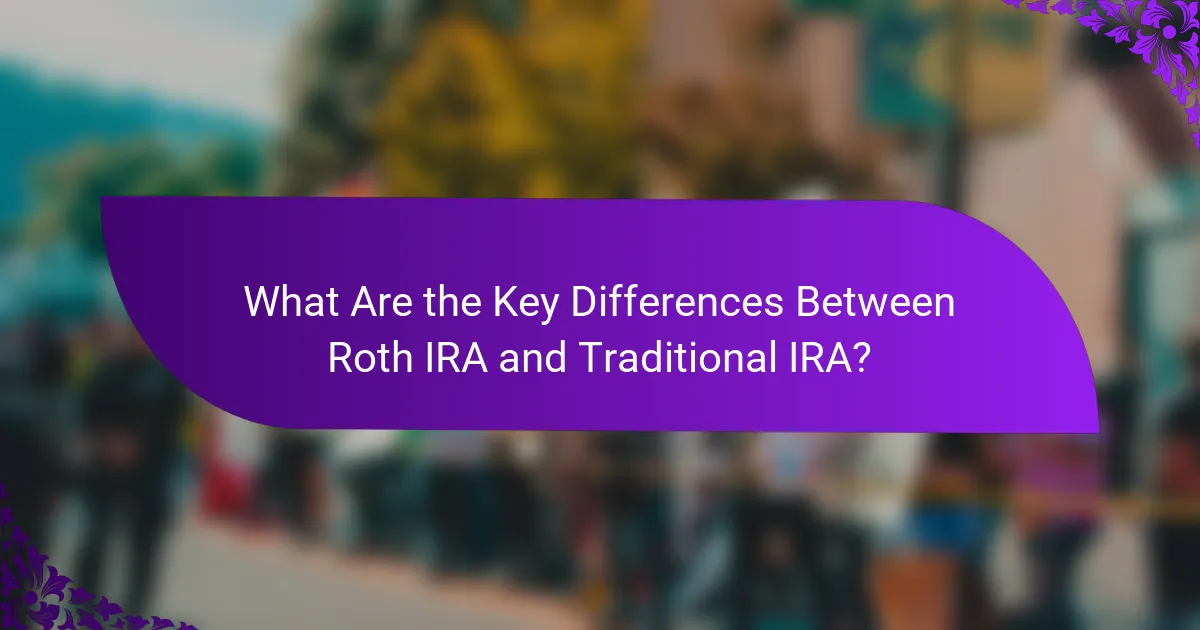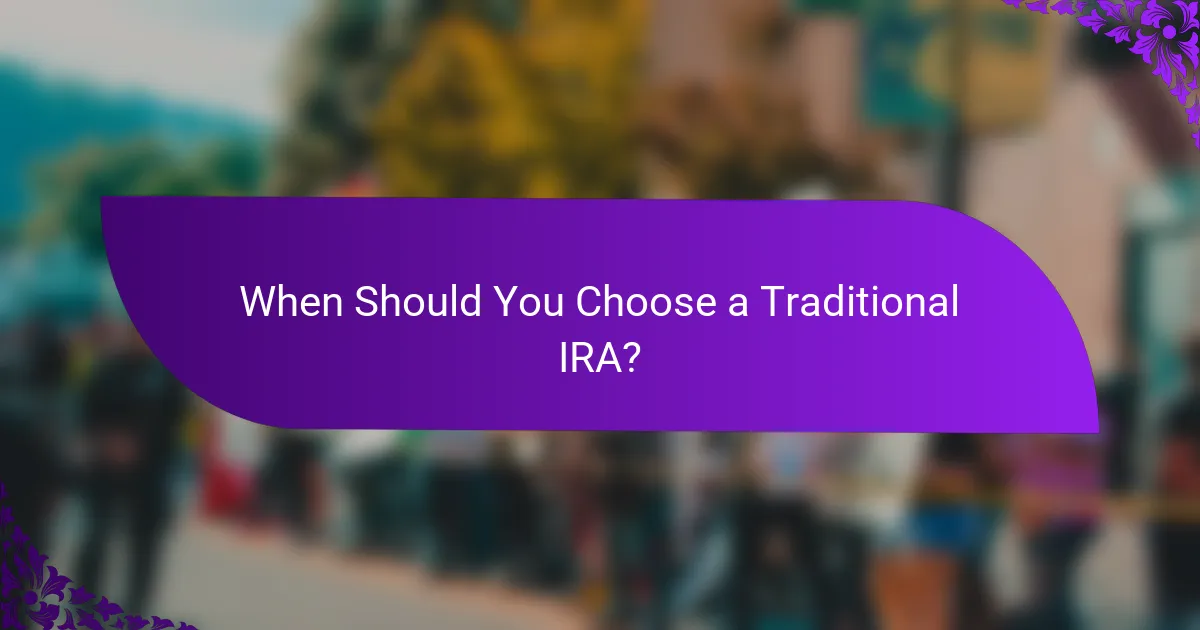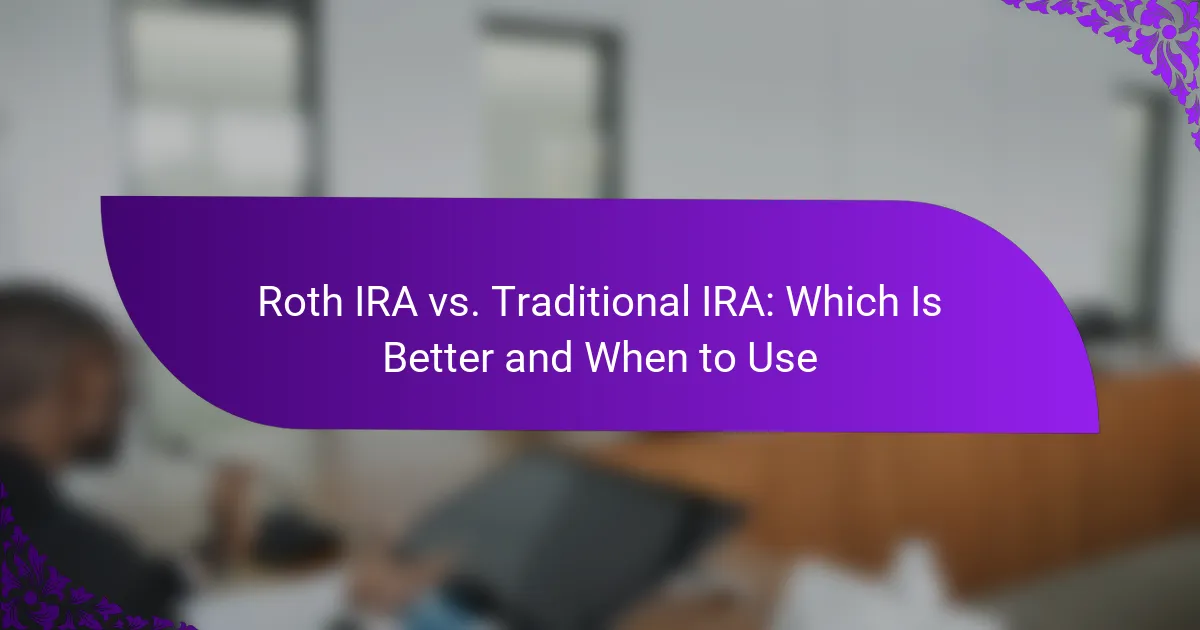Choosing between a Roth IRA and a Traditional IRA is crucial for effective retirement planning, as each account offers distinct tax advantages and withdrawal rules. A Roth IRA is ideal for those expecting higher taxes in retirement, allowing for tax-free withdrawals, while a Traditional IRA suits individuals anticipating lower tax rates later, offering immediate tax deductions on contributions. Understanding these differences can guide you in selecting the account that aligns best with your financial goals.

What Are the Key Differences Between Roth IRA and Traditional IRA?
The key differences between a Roth IRA and a Traditional IRA revolve around tax treatment, withdrawal rules, contribution limits, eligibility requirements, and investment options. Understanding these distinctions can help you choose the right retirement account based on your financial situation and goals.
Tax treatment
With a Traditional IRA, contributions are typically tax-deductible, meaning you can lower your taxable income in the year you contribute. However, withdrawals during retirement are taxed as ordinary income. In contrast, Roth IRA contributions are made with after-tax dollars, allowing for tax-free withdrawals in retirement, provided certain conditions are met.
This tax treatment difference can significantly impact your overall tax strategy. If you expect to be in a higher tax bracket during retirement, a Roth IRA may be more beneficial, while a Traditional IRA might be advantageous if you anticipate a lower tax rate in the future.
Withdrawal rules
Withdrawal rules differ notably between the two accounts. Traditional IRAs require you to start taking minimum distributions at age 72, and early withdrawals before age 59½ may incur a penalty and taxes. Conversely, Roth IRAs allow you to withdraw your contributions at any time without penalties, and qualified withdrawals of earnings are tax-free after age 59½, provided the account has been open for at least five years.
This flexibility in withdrawal rules can make Roth IRAs appealing for those who may need access to funds before retirement age.
Contribution limits
Both Roth and Traditional IRAs have the same contribution limits, which are set annually by the IRS. As of 2023, individuals can contribute up to $6,500 per year, or $7,500 if they are age 50 or older. However, income limits apply to Roth IRAs, which can restrict high earners from contributing directly.
For Traditional IRAs, the ability to deduct contributions may phase out based on your income and whether you or your spouse are covered by a retirement plan at work.
Eligibility requirements
Eligibility for these accounts varies. Anyone with earned income can contribute to a Traditional IRA, but the tax deductibility may be limited based on income and retirement plan coverage. For Roth IRAs, eligibility is contingent on your modified adjusted gross income (MAGI); individuals earning above certain thresholds may not be able to contribute directly.
Understanding these eligibility requirements is crucial for effective retirement planning and maximizing contributions.
Investment options
Both Roth and Traditional IRAs offer a wide range of investment options, including stocks, bonds, mutual funds, and ETFs. The specific options available depend on the financial institution managing the account. Generally, both types of IRAs provide similar investment flexibility, allowing you to tailor your portfolio to your risk tolerance and retirement goals.
When choosing an IRA provider, consider the fees, available investment choices, and any additional services offered, as these can impact your overall investment strategy.

When Should You Choose a Roth IRA?
You should consider a Roth IRA if you expect your tax rate to be higher in retirement than it is now. This account allows you to pay taxes on your contributions upfront, providing tax-free withdrawals later, which can be beneficial for long-term savings.
Lower current tax rate
If your current tax rate is relatively low, contributing to a Roth IRA can be advantageous. By paying taxes now, you lock in a lower rate, which can save you money in the long run, especially if you anticipate higher income in the future.
For example, if you are in the 12% tax bracket now but expect to be in the 22% bracket later, a Roth IRA can be a smart choice. This is particularly relevant for younger investors or those in the early stages of their careers.
Long-term investment horizon
A Roth IRA is ideal for individuals with a long-term investment horizon. The longer your money can grow tax-free, the more you can benefit from compound interest. This makes it a suitable option for those who are planning for retirement several decades away.
Consider starting a Roth IRA in your 20s or 30s. Even small contributions can accumulate significantly over time, especially if invested in growth-oriented assets like stocks.
Desire for tax-free withdrawals
If you want to enjoy tax-free withdrawals during retirement, a Roth IRA is the way to go. Unlike traditional IRAs, where withdrawals are taxed as ordinary income, Roth IRA withdrawals are tax-free, provided certain conditions are met.
This feature can significantly enhance your retirement income strategy. For instance, if you withdraw funds from a Roth IRA after age 59½ and have held the account for at least five years, you won’t owe any taxes on those withdrawals, allowing you to maximize your retirement funds.

When Should You Choose a Traditional IRA?
A Traditional IRA is often the better choice when you anticipate being in a lower tax bracket during retirement compared to your current situation. This type of account allows for tax-deductible contributions, which can be beneficial if you need immediate tax relief.
Higher current tax rate
If you are currently in a higher tax bracket, contributing to a Traditional IRA can provide significant tax savings. Contributions to this account may be fully or partially deductible, reducing your taxable income for the year. This can be particularly advantageous if you expect your tax rate to decrease in retirement.
For example, if you are in the 24% tax bracket now and expect to retire in the 12% bracket, you could save substantially on taxes by deferring them until retirement.
Shorter investment horizon
A Traditional IRA is suitable for those who plan to retire in the near future. If you are within a decade of retirement, the benefits of tax deferral may outweigh the advantages of a Roth IRA. With a shorter investment horizon, you may not have enough time to fully benefit from the tax-free growth offered by a Roth IRA.
In this case, the immediate tax deduction from a Traditional IRA can provide more immediate financial relief and allow for more aggressive investment strategies as you approach retirement.
Need for tax deductions
If you require tax deductions to lower your current taxable income, a Traditional IRA is a strong option. Contributions can help reduce your overall tax burden, which can be particularly useful if you are facing high expenses or fluctuating income.
Consider this: if you contribute $6,000 to a Traditional IRA and you are in the 22% tax bracket, you could potentially save around $1,320 in taxes for that year. This immediate benefit can help with cash flow and financial planning.

How Do Contribution Limits Affect Your Choice?
Contribution limits play a crucial role in deciding between a Roth IRA and a Traditional IRA. These limits dictate how much you can save each year, which can influence your tax strategy and retirement planning.
Annual contribution limits
Choosing between the two types of IRAs can depend on your current tax situation and future expectations. If you anticipate being in a higher tax bracket during retirement, a Roth IRA may be more beneficial, as contributions are made with after-tax dollars, allowing for tax-free withdrawals later.
Catch-up contributions for older adults
Catch-up contributions are designed to help individuals aged 50 and older save more for retirement. In 2023, this allows an additional $1,000 for Traditional and Roth IRAs, bringing the total to $7,500 for those eligible.
Utilizing catch-up contributions can significantly enhance your retirement savings, especially if you started saving later in life. It’s a strategic way to bolster your retirement fund while still benefiting from the tax advantages that each IRA type offers.

What Are the Tax Implications of Each Option?
The tax implications of a Roth IRA and a Traditional IRA differ significantly, affecting when and how you pay taxes on your contributions and withdrawals. Understanding these differences is crucial for making informed retirement planning decisions.
Tax benefits of Roth IRA
A Roth IRA allows you to contribute after-tax dollars, meaning you pay taxes on your income before you deposit it into the account. The primary benefit is that qualified withdrawals during retirement are tax-free, including both contributions and earnings, provided certain conditions are met.
This tax-free growth can be particularly advantageous for younger investors or those expecting to be in a higher tax bracket in retirement. Additionally, Roth IRAs do not have required minimum distributions (RMDs) during the account holder’s lifetime, allowing your investments to grow longer.
Tax benefits of Traditional IRA
Contributions to a Traditional IRA may be tax-deductible, reducing your taxable income in the year you contribute. This can be beneficial for individuals in higher tax brackets, as it lowers their current tax burden. However, taxes are due upon withdrawal during retirement, which can lead to a higher tax rate if your income increases.
Traditional IRAs also have RMDs starting at age 73, requiring you to withdraw a minimum amount each year, which can impact your taxable income in retirement. Weighing the immediate tax benefits against future tax implications is essential when choosing this option.

How Do Income Levels Impact IRA Choices?
Income levels significantly influence the choice between a Roth IRA and a Traditional IRA. Generally, higher earners may face contribution limits for a Roth IRA, while a Traditional IRA offers tax-deductible contributions based on income thresholds.
Income limits for Roth IRA
For the 2023 tax year, individuals with a modified adjusted gross income (MAGI) above $138,000 and married couples filing jointly with a MAGI above $218,000 face reduced contribution limits for a Roth IRA. Those earning above $153,000 for singles or $228,000 for couples are ineligible to contribute directly to a Roth IRA.
It’s essential to monitor your income level annually, as it can change due to salary increases or other factors. If you exceed the Roth IRA income limits, consider a Traditional IRA or a backdoor Roth IRA strategy, which involves contributing to a Traditional IRA and then converting it to a Roth IRA.
Always consult with a financial advisor to navigate these options effectively, especially if your income fluctuates or if you anticipate changes in your financial situation. Understanding these limits can help you maximize your retirement savings strategy.
